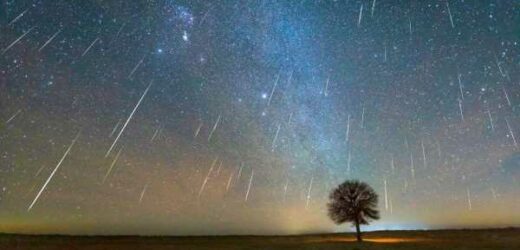World Meteorological Organisation shares climate report for Europe
We use your sign-up to provide content in ways you’ve consented to and to improve our understanding of you. This may include adverts from us and 3rd parties based on our understanding. You can unsubscribe at any time. More info
A Geminid meteor shower, creating stunning streaks of light in the skies, will peak tonight and tomorrow making it quite the spectacle for anyone armed with a telescope. Meteors are pieces of space rock that can enter the Earth’s atmosphere at speeds of up to 70 kilometres per second. As they are vaporised, they create illuminations in the sky. But for stargazers in the UK, there is one reason why this year’s show may not be as obvious as it has been before. And it’s all to do with the brightness and positioning of the Moon.
What are Geminid meteor showers?
Geminid meteor showers are known for being particularly bright, moderately fast and are made up of a visually striking array of colours – mainly white, but with some yellow and a few splotches green, red and blue.
This is partly caused by the traces of metals like sodium and calcium found in the meteors, resulting in the same effect used to make fireworks colourful. The renowned showers have been known to produce over 100 meteors per hour at its peak. However, light pollution and other factors mean that far fewer meteors can actually be spotted.
The shower also tends to favour lucky spectators in the Northern Hemisphere, and it appears in the Gemini constellation. You can catch the clearest glimpse once night falls, and the darker the conditions the better.
Meteorologists also advise that you avoid light pollution, suggesting stargazers and photographers avoid built-up areas and head to the countryside, or a national park.


The best viewing platforms
Optimal conditions would be a dark location far from stray lights. It is also advised that you give yourself at least 20 minutes to let your eyes adapt adjust to the darkness.
Some of the best stargazing spots across Britain include renowned locations, including the three famous Dark Sky Reserves – Snowdonia, Brecon Beacons and Exmoor national parks. Another great spot, which has been dubbed Europe’s largest Dark Sky Park, is at Northumberland National Park and the adjoining Kielder Water and Forest Park.
While Geminids meteors look as though they radiate from near the bright star Castor in the constellation Gemini, the shooting stars are actually a debris stream left behind by asteroid 3200 Phaethon. This makes it one of the only major meteor showers not to originally come from a comet.
Geminids were first spotted in 1862, far more recently than other showers such as the Perseids and Leonids. The meteroties are also thought to be getting more intensive every year they zip through the planet’s atmosphere.

But there’s a slight hindrance this year…
Anna Gammon-Ross, astronomer at Royal Observatory in Greenwich said: “The meteors will be visible in the east of the sky from around 6pm – but will appear all around the sky later in the night.
“Unfortunately, the waning gibbous moon will make it trickier to see the meteors during the peak night this year. The gibbous phases are when the near side of the moon is over halfway lit up by the Sun, meaning it will appear very bright in our skies. This will make it difficult to see any other celestial objects nearby.”
According to EarthSky, a dark sky with a less illuminating moon would present the chance for spectators to see 120 Geminid meteors per hour. But these conditions are almost guaranteed not to be as favourable this year.
Those who do manage to catch a glimpse will be instead treated to a brief show.
DON’T MISS
NASA hits milestone as James Webb captures oldest known galaxies [REVEAL]
Wholesale electricity price in UK soars to record high as solar slumps [INSIGHT]
Apollo 17: NASA’s last Moon mission and why we haven’t been back since [REPORT]


Meteors are mostly pieces of comet dust and ice that are actually not even larger than a grain of rice. But meteorites, which are rocks broken off asteroids in the asteroid belt between Mars and Jupiter, can weigh as much as 60 tonnes.
They are made up of minerals rich in silicon and oxygen, mainly consisting of iron and nickel, or a combination of the two. Scientists believe that aroun 1,000 tons to more than 10,000 tons of material from meteors rain down on Earth daily. But NASA said they are mainly dust-like grains that pose no threat to the planet.
Any meteor bigger than a grape will produce a fireball, which is frequently accompanied by a persistent afterglow that is refereed to as a meteor train. This is a column of ionised gas that becomes less visible as it loses energy.
National Geographic’s website states: “With each orbit, that process creates a stream of debris along the comet’s path that persists long after the dirty iceball has headed back out to the edges of the solar system.”
Source: Read Full Article

